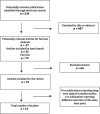Effects of modified abutment characteristics on peri-implant soft tissue health: A systematic review and meta-analysis
- PMID: 29072346
- PMCID: PMC6084371
- DOI: 10.1111/clr.13097
Effects of modified abutment characteristics on peri-implant soft tissue health: A systematic review and meta-analysis
Abstract
Objectives: The purpose of this systematic review was to evaluate the impact of the abutment characteristics on peri-implant tissue health and to identify the most suitable material and surface characteristics.
Methods: A protocol was developed aimed to answer the following focused question: "Which is the effect of the modification of the abutment design in regard to the maintenance of the peri-implant soft tissue health?" Further subanalysis aimed to investigate the impact of the abutment material, macroscopic design, surface topography and surface manipulation. Randomised controlled trials (RCTs) with a follow-up of at least 6 months after implant loading were considered as inclusion criteria. Meta-analyses were performed whenever possible.
Results: Nineteen final publications from thirteen investigations were included. The results from the meta-analysis indicated that zirconia abutments (Zi) experienced less increase in BOP values over time [n = 3; WMD = -26.96; 95% CI (-45.00; -8.92); p = .003] and less plaque accumulation [n = 1; MD = -20.00; 95% CI (-41.47; 1.47); p = .068] when compared with titanium abutments (Ti). Bone loss was influenced by the method of abutment decontamination [n = 1; MD = -0.44; 95% CI (-0.65; -0.23); p < .001]. The rest of the studied outcomes did not show statistically significant differences.
Conclusions: The macroscopic design, the surface topography and the manipulation of the implant abutment did not have a significant influence on peri-implant inflammation. In contrast, the abutment material demonstrated increased BOP values over time for Ti when compared to Zi abutments.
Keywords: dental abutment; dental implants; dental-implant abutment surface; mucositis; systematic review.
© 2017 John Wiley & Sons A/S. Published by John Wiley & Sons Ltd.
Figures
References
-
- Abrahamsson, I. , Berglundh, T. , Wennstrom, J. , & Lindhe, J. (1996). The peri‐implant hard and soft tissues at different implant systems. A comparative study in the dog. Clinical Oral Implants Research, 7, 212–219. - PubMed
-
- Abrahamsson, I. , Zitzmann, N. U. , Berglundh, T. , Linder, E. , Wennerberg, A. , & Lindhe, J. (2002). The mucosal attachment to titanium implants with different surface characteristics: An experimental study in dogs. Journal of Clinical Periodontology, 29, 448–455. - PubMed
-
- Abrahamsson, I. , Zitzmann, N. U. , Berglundh, T. , Wennerberg, A. , & Lindhe, J. (2001). Bone and soft tissue integration to titanium implants with different surface topography: An experimental study in the dog. International Journal of Oral and Maxillofacial Implants, 16, 323–332. - PubMed
-
- Andersson, B. , Glauser, R. , Maglione, M. , & Taylor, A. (2003). Ceramic implant abutments for short‐span fpds: A prospective 5‐year multicenter study. International Journal of Prosthodontics, 16, 640–646. - PubMed
-
- Andersson, B. , Scharer, P. , Simion, M. , & Bergstrom, C. (1999). Ceramic implant abutments used for short‐span fixed partial dentures: A prospective 2‐year multicenter study. International Journal of Prosthodontics, 12, 318–324. - PubMed
Publication types
MeSH terms
Substances
LinkOut - more resources
Full Text Sources
Other Literature Sources
Medical



